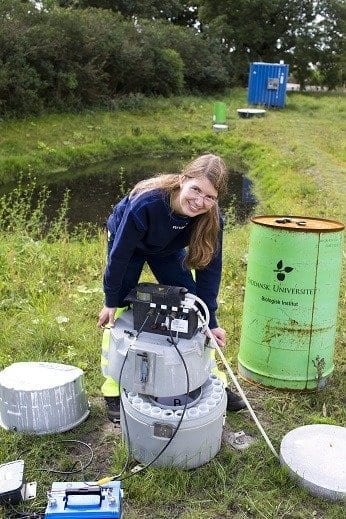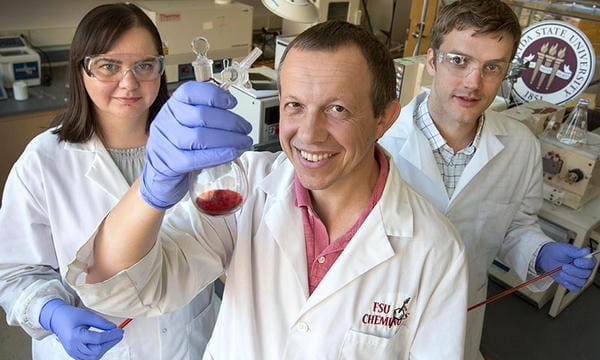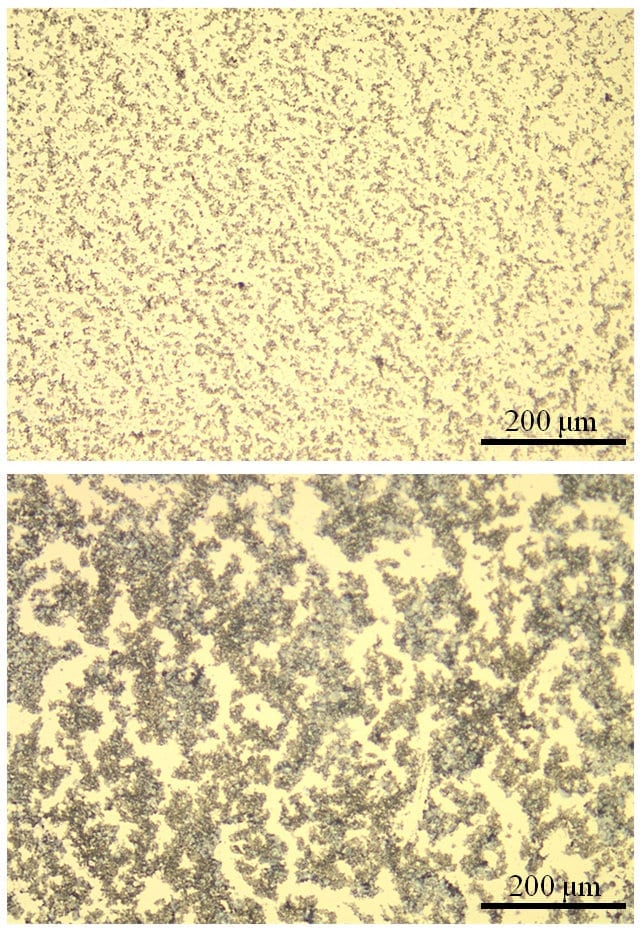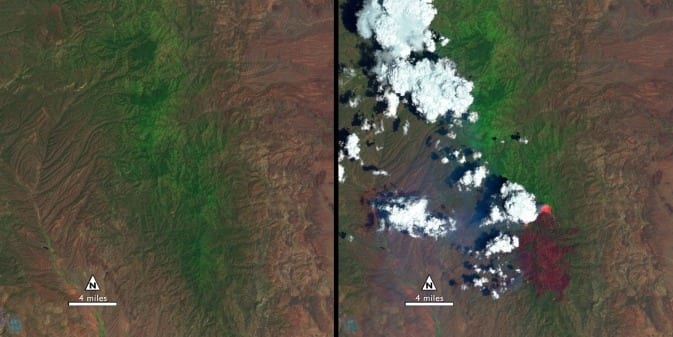
Lakes and streams are often receiving so much phosphorous that it could pose a threat to the local aquatic environment.
Now, research from the University of Southern Denmark shows that there is an easy and inexpensive way to prevent phosphorus from being discharged to aquatic environments. The solution is crushed concrete from demolition sites.
Usually we think of demolished concrete walls and floors as environmental contaminants, but in fact this material may turn out to be a valuable resource in nature protection work. This is the conclusion from researchers from University of Southern Denmark after studying the ability of crushed concrete to bind phosphorus.
“We have shown that crushed concrete can bind up to 90 per cent of phosphorus, “says PhD student and environmental engineer, Melanie Sønderup, Department of Biology at the University of Southern Denmark.
Contributors to the research are also postdoc, PhD, Sara Egemose and associate professor Mogens Flindt from the same place. Since March 2013 the researchers have tested the technique in a full-scale experiment, which will run until March 2014. But already now they find that the technique is very effective.
Large amounts of phosphorus can be washed out into lakes and streams when it rains. Rainwater that runs off from catchments, especially those fertilized with phosphorus, carries the phosphor with it. This phosphorus rich rainwater is then often collected in rainwater ponds, which discharges into lakes and streams.
“The water in these rainwater ponds can be very rich in phosphorus, and if it is discharged into a lake, it can lead to an increase in algae growth. This can lead to oxygen depletion and a reduction in the number of species that can live in the water,” explains Melanie Sønderup and continues:
“By letting the pond water pass through a filter of crushed concrete, we can remove up to 90 per cent of the phosphorus”.
Phosphorus binds so well to the concrete because it contains cement. Cement is rich in calcium and also contains aluminum and iron. All three can bind phosphorus. Preliminary results show that the size of concrete grains is of importance. The smaller the grains the better they bind phosphorous. Fine concrete powder is thus more effective than millimeter sized concrete bits.
“It is also important that we do not use concrete that has been exposed to wind and rain for a long time, as this washes out the cement, which holds the essential calcium,” explains Melanie Sønderup.
As the experiments have only run for six months, the scientists do not yet know the durability of crushed concrete, but they believe that a filter of crushed concrete can last for a long time, probably several years.
The Latest Bing News on:
Phosphorus
- Chesapeake Bay Program announces reduction of pollution from all seven jurisdictionson May 8, 2024 at 5:51 am
The Chesapeake Bay Program announced last week that the seven jurisdictions that make up the Chesapeake Bay watershed continue to make progress in reducing the amount of nitrogen, phosphorus and ...
- Ask A Nutrition Professional: What Do Sweet Potatoes Contain In Terms Of Potassium And Phosphorus?on May 7, 2024 at 2:28 pm
Expert opinion from Livia Dickson Chen PhD in Nutrition · 11 years of experience · Brazil In 100 grams of cooked sweet potato there are approximately 15.4 mg of phosphorus and 148.4 mg of potassium.
- Professional Faqs: What Do Sweet Potatoes Contain In Terms Of Potassium And Phosphorus?on May 7, 2024 at 2:28 pm
Dietetics and Clinical Nutrition Services · 7 years of experience · South Africa Sweet potatoes are exceptionally nutrient dense and contain both potassium and phosphorus. Sweet potato contains around ...
- New method efficiently recovers phosphorus from sewage sludgeon May 6, 2024 at 5:13 am
Researchers at Hokkaido University have developed a method to recover phosphorus from sewage sludge ash, which remains after the sludge has been burned for electric power generation.
- Phosphorus Enriched Organic Manure Market Analysis: Projected Increase to US$ 6,347.6 Million by 2034, with a CAGR of 6.5%on April 30, 2024 at 11:08 pm
The growing demand for organic products that are environment is driving the demand for phosphate rich organic manure in the market.
- Report: Pa. chicken plant pollutes waterways with millions of pounds of nitrogen, phosphoruson April 30, 2024 at 7:00 am
A Tyson Foods plant in Lancaster County is one of several Tyson plants that researchers say discharged pollutants by piping wastewater into waterways.
- Maps developed with artificial intelligence confirm low levels of phosphorus in Amazonian soilon April 28, 2024 at 5:00 pm
The impact of this is that a lack of phosphorus affects the growth cycle of species and can, for example, prevent trees from reacting to the increase in carbon dioxide associated with climate change.
- Recovering phosphorus from sewage sludge ash to address problem of diminishing supplies of phosphorus oreson April 26, 2024 at 7:15 am
Valuable supplies of phosphorus could be recovered from sewage sludge ash, which remains after the sludge has been burned for electric power generation. The method has been developed by chemical ...
- Recovering phosphorus from sewage sludge ashon April 25, 2024 at 5:00 pm
Chemical and heat treatment of sewage sludge can recover phosphorus in a process that could help address the problem of diminishing supplies of phosphorus ores. Chemical and heat treatment of ...
- Top 6 Best Phosphorus Supplements in 2024on April 24, 2024 at 5:00 pm
Phosphorus is a crucial mineral necessary for the development and upkeep of bones and teeth. It plays a role in the generation of energy and the control of kidney functions. Although phosphorus is ...
The Latest Google Headlines on:
Phosphorus
[google_news title=”” keyword=”Phosphorus” num_posts=”10″ blurb_length=”0″ show_thumb=”left”]
The Latest Bing News on:
Old concrete
- Sarasota OKs demolition of 112-year-old historic house to make way for new developmenton May 8, 2024 at 1:07 am
The Virginia-based developer first made the demolition request to clear the way for a mixed-use development across more than 3 acres along Cross Street last May. The Sarasota Historic Preservation ...
- 19-year-old riding motorcycle dies after crashing into concrete wall, light poleon May 7, 2024 at 11:36 am
DETROIT – Two motorcycles were traveling at high speed when one of the riders lost control, struck a concrete wall, was thrown off and hit a light pole, police said. It happened 11:30 p.m. Monday on ...
- 18-year-old rescued in abandoned missile silo after falling 30 feeton May 6, 2024 at 3:32 pm
DEER TRAIL, Colo. (KUSA) - Apparently ignored signs led to a dangerous rescue Sunday morning. Arapahoe County Sheriff’s Office said a group of young people entered an old missile silo. One of them, an ...
- 18-year-old rescued after 30-foot plunge into abandoned missile silo, Colorado cops sayon May 6, 2024 at 6:42 am
An 18-year-old man who fell 30 feet while exploring an abandoned missile silo required an hours-long rescue, Colorado sheriff’s officials reported. Deputies responded at 3:30 a.m. Sunday, May 5, to a ...
- ‘Concrete offer’ from Newcastle could be on way – 22-year-old South American may be a Magpie soonon May 6, 2024 at 2:16 am
Earlier this year, we covered claims from Argentina that Newcastle United had sent a scout to watch Boca Juniors’ Kevin Zenón. On April 11th, Boca Noticias reported the Magpies are still following the ...
- Trapped driver rescued from concrete truck in Woodlandon May 5, 2024 at 5:00 pm
According to a post on Clark-Cowlitz Fire Rescue’s Facebook page, the crash occurred around 9:22 a.m. Saturday on Old Pacific Highway and Green Mountain Road in Woodland. Clark-Cowlitz Fire Rescue’s ...
- Fatal CT Crash: 23-Year-Old ID'd As Victimon May 5, 2024 at 9:20 am
A 23-year-old was killed in an overnight crash in Connecticut.It happened in Hartford County just before 11 p.m. Saturday, May 4, in Windsor.Connecticut State Police said a 2024 Kawasaki was traveling ...
- Asphalt or concrete lanes? Both are used on 405 Freeway and elsewhereon May 3, 2024 at 6:16 am
The Orange County Transportation Authority recently oversaw the $2.16 billion widening of the 405 in that stretch, between the 605 Freeway and the 73, and largely used concrete for the new lanes and ...
- 25-year-old driver killed after car 'launches' into concrete pillar in Utah Countyon April 28, 2024 at 5:20 pm
BENJAMIN, Utah (KUTV) — A man died after officials said his car "launched" off a concrete wall and rolled into a pillar on an underpass in Utah County. The driver was identified on Monday as ...
- A New Use for Old Concrete Could Revolutionize Carbon Captureon April 25, 2024 at 6:30 am
Rock weathering is a natural process where minerals in the soil can capture carbon and sequester it as calcium carbonate in the oceans, but the process is an incredibly slow one. An Irish startup ...
The Latest Google Headlines on:
Old concrete
[google_news title=”” keyword=”Old concrete” num_posts=”10″ blurb_length=”0″ show_thumb=”left”]










